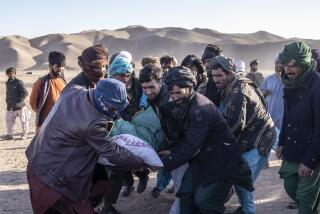Two Afghanistan bombings aimed at Shiites kill at least 59 people
- Share via
Reporting from Kabul, Afghanistan, and Islamabad, — Bomb blasts targeting Shiite Muslim gatherings Tuesday in two Afghan cities killed at least 59 people and injured 150, a rare outbreak of sectarian violence in a country racked by 10 years of war with Taliban insurgents.
A noontime blast in Kabul, the capital, involved a suicide bomber hidden among a throng of Shiite worshipers outside the Abul Fazal Abbas shrine, said Gen. Mohammed Zahir, head of criminal investigations for the Kabul police. That attack killed at least 55 people and injured 134, the Interior Ministry said.
At about the same time in the northern city of Mazar-i-Sharif, a bomb on a bicycle detonated near a gathering of Shiites, killing at least four people and injuring 16, provincial and Interior Ministry officials said.
The bomb exploded as a Shiite procession was heading toward a city shrine, said Gen. Abdul Taj, a top police official in Balkh province, where Mazar-i-Sharif is located. Another nearby bomb probably meant for the procession was found and defused, Taj said.
The attacks occurred on the Shiite holy day of Ashura, which commemorates the anniversary of the 7th century martyrdom of Imam Hussein, a grandson of the prophet Muhammad.
Speaking at a news conference in Berlin, Afghan President Hamid Karzai said the attacks marked “the first time that on such an important religious day in Afghanistan, terrorism of that horrible nature is taking place.”
Marine Corps Gen. John Allen, commander of U.S.-led coalition forces in Afghanistan, condemned the violence and blamed Afghan insurgents for the attacks. “This insurgency, which wraps itself in a false veil of Islam, must know that killing innocent pilgrims will spell their own demise,” Allen said in a prepared statement.
The Afghan Interior Ministry also accused Afghan Taliban insurgents of being behind the attacks.
Taliban spokesman Zabiullah Mujahid denied that the Afghan insurgent group was involved and instead accused U.S.-led forces of carrying out such violence “to provide grounds for their presence in Afghanistan, and to pit [Afghans] against each other.”
Witnesses outside the shrine in Kabul said corpses and severed limbs were strewn all over the street. A steady stream of ambulances and police cars rushed the injured to nearby hospitals. Many of the victims were women and children. Gen. Mohammad Ayub Salangi, Kabul’s police chief, said the bomber entered the city with a procession of pilgrims from the nearby province of Lowgar.
It was Kabul’s deadliest attack since a suicide car bomber killed more than 60 people outside the Indian Embassy in July 2008.
“I was about to go to the shrine, but then I heard a big explosion about 10 meters away,” said Allah Mohammad, 25. “As people rushed, I fell down, and after a few minutes stood up again to look for two of my friends who were with me. I saw more than 25 dead bodies on the ground. Some children were also killed and wounded. It was a very bad situation.”
Afghanistan’s Muslim population is majority Sunni, but sectarian violence is rare. Such attacks are much more common in neighboring Pakistan, where Sunni extremist organizations routinely carry out terror strikes against Shiites, whom they regard as heretics.
Shiites make up about 15% of Afghanistan’s population.
Special correspondent Baktash reported from Kabul and Times staff writer Rodriguez from Islamabad.
More to Read
Sign up for Essential California
The most important California stories and recommendations in your inbox every morning.
You may occasionally receive promotional content from the Los Angeles Times.










